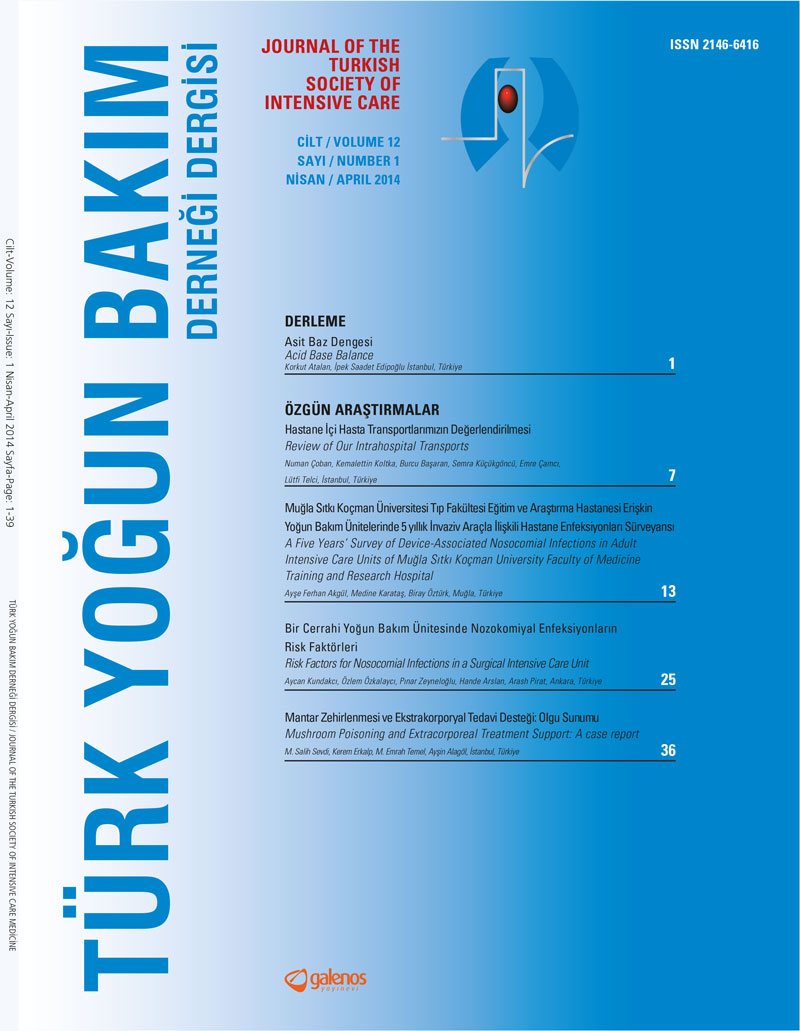Abstract
Objective:
The most frequentlyseen intensive care unit (ICU) acquired infections are catheter related bloodstream infections (CR-BSI), ventilator associated pneumonia (VAP), and catheter associated urinary tract infections (CA-UTI). We conducted this study to determine the risk factors of CR-BSI, VAP, and CA-UTI in surgical ICU patients admitted to Başkent University Ankara Hospital.
Material and Method:
Following Institutional Review Board approval we performed this retrospective study, including patients admitted to surgical ICU between January 2009 and July 2012. Patients’ demographical features, 26 underlying diseases, features related to ICU course were recorded.
Results:
Out of 876 patients admitted to surgical ICU between January 2009 and July 2012, patients who stayed in ICU ≤ 2 days or died within the first 2 days of ICU were excluded. Out of 103 patients who were included in the final analysis, 60 were (58%) diagnosed with nosocomial infections (CR-BSI, VAP, and CA-UTI) and were compared to those who were not. Twenty five (24%) out of 60 infected patients had CR-BSE, 46 (45%) had VAP and 20 (19%) had CA-UTI. Higher APACHE II scores (OR: 1.142; 95%CI: 1.007-1.294; p=0.039), comorbidity (OR: 39.488; 95%CI: 2.075-750.950; p=0.014), prolonged hospitalization prior to ICU (OR: 1.155; 95%CI: 1.015-7.953; p=0.029), and sedation (OR: 10.980; 95%CI: 1.167-103.337; p=0.036) were identified as risk factors for nosocomial infections. Advanced age (OR: 1.037; 95%CI: 1.001-1.073; p=0.042) was determined as risk factor for CR-BSE. Diabetes mellitus (OR: 12.048; %95CI: 1.157-125.000; p=0.037), immunosupression (OR: 16.949, %95 CI: 2.463-111.111; p=0.004), open wound (OR: 5.714; 95%CI: 1.017-37.258; p=0.048), higher APACHE II scores (OR: 1.132; 95%CI: 1.022-1.254; p=0.018), and prolonged duration of mechanical ventilation (OR: 1.084;95%CI: 1.002-1.171; p=0.043) were determined as risk factors for VAP. Prolonged hospitalization prior to ICU (OR: 1.037; 95%CI: 1.004-1.072; p=0.027) was determined as risk factor for CA-UTI.
Conclusion:
To conclude, higher APACHE II scores, comorbidity and immunosuppression, use of sedatives, prolonged hospitalization and mechanical ventilation, advanced age, and presence of open wound were found to be the risk factors for these infections.
Keywords: ICU acquired nosocomial infections, risk factors, ventilator associated pneumonia, catheter related bloodstream infection, catheter iated urinary tract infection
Copyright and license
Copyright © 2014 The Author(s). This is an open access article distributed under the Creative Commons Attribution License (CC BY), which permits unrestricted use, distribution, and reproduction in any medium or format, provided the original work is properly cited.





















